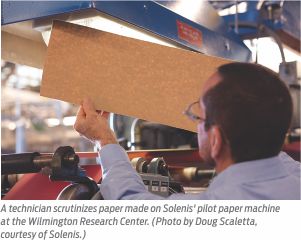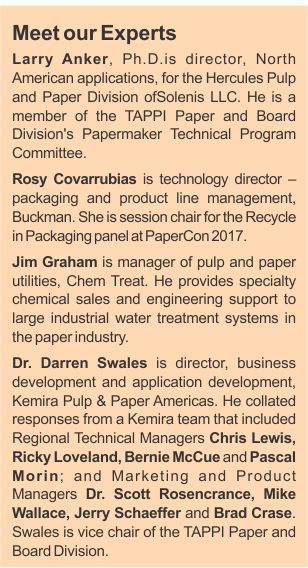What are the factors sparking modern developments in paper chemistry? Where might these innovations lead us?
By Jan Bottiglieri, Editorial Director, Paper360°
We’ve all heard that “necessity is the mother of invention.” In other words, innovation doesn’t happen in a vacuum: it is sparked by demand.Perhaps, then, it’s fortunate that papermakers are beset by demands from all sides. End users who want improved product performance and new products to meet changing lifestyles, stakeholders who demand cost control, a global environmental community pressuring for sustainable use of resources—all of these require pulp and paper producers to constantly adapt, improve, and innovate.
As paper science and laboratory capabilities haveadvanced, the complex chemistry of producing pulp and paper has offered tremendous opportunities for meeting those demands: creating new grades, imbuing paper with new properties, and adjusting the process to be more sustainable in its use (and re-use) of water and fiber.So we asked experts from within the supplier community (see sidebar)to weigh in on what drives innovation in paper chemistry. What are the “necessities” leading to today’s most exciting developments? Where might these innovations lead in the future?
Innovation drivers
All agree that there are a variety of needs sparking innovation today—the desire for improvements in product quality, productivity, sustainability, cost, and automation all play a role, among other drivers. Rather than being mutually exclusive, these needs are interconnected in complex ways, and all must be considered for the best outcome.
“For example, recycle packaging manufacturers want to produce lighter basis weights with lower quality furnish while maintaining strength targets. This trend has a direct impact on quality, productivity, cost and sustainability,” says Larry Anker of Solenis. “The drive towards water reuse/water closure is another area that is driving innovation. Using less fresh water and the subsequent cycle-up of contaminants impacts the performance of wet end chemistry. We are creating a wide range of alternative solutions that are effective in these more challenging environments.”
Darren Swales of Kemira breaks these “non mutually-exclusive” drivers into two broad categories: new grade development based on emerging consumer demands, and optimization of machine efficiency. Grade and chemistry development is multi-faceted; modern papermakers are focusing most on environmental compatibility, repulpability, compostability and sustainability. “Modified cellulose, nanocellulose, and associated derivatives open the window for new additives and interaction with wet end chemistry and paper properties,” he notes.
Other significant drivers in this area include paper strength and raw material cost. The use of cheaper, weaker fiber sources is becoming necessary for manufacturers who want stay competitive, particularly in North America. Especially for packaging producers, using fiber that is intrinsically weaker and much less reactive is challenging when trying to maintain runnability and end use quality, says Swales. For printing and writing grades, reducing fiber costs is paramount for North American assets that want to compete in the global economy; on average, North American machines are older than in other regions of the world. “Higher levels of fiber substitution with fillers is necessary, while having sheet properties (stiffness, surface strength) that still perform in the press room—and with consumers, since the advent of on-demand printing and customization—is more important now than ever.
“As for improving paper machine efficiency, it means doing more with less,” Swales adds. “This means less fiber, less water, and less energy. Water quality and quantity management are key. From issues generated by mill water system closure, to new technologies such as foam forming, chemical suppliers are continually challenged to provide products and processes that focus on these goals.”
This “more with less” necessity is driven by increased competition for limited resources. “I believe that in today’s world of scarce raw materials, increasing energy costs, and increasing regulations, managing resources more sustainably will be the biggest driver for innovation,” saysBuckman’s Rosy Covarrubias. “We are seeing trends such as light-weighting of packaging grades across all manufacturers, so any chemical innovation that can help achieve the new targets will be more than welcome. Sustainability is still a big driver, as most companies have learned that being sustainable does not mean spending more money.”
Because paper and packaging products touch every facet of life, even hard-to-predict social and lifestyle trends spark innovation. “Environmental pressure will impact the materials used in everyday items such as Keurig cups, requiring a more compostable cup, for example. The continued shift to a virtual workplace will impact demand for certain grades, both up and down. The growth of home delivery services will affect products used in the packaging and shipping industry,” says Jim Grahamof ChemTreat.
Adds Anker, “The retiring workforce is another driver of innovation that is gradually impacting our customers.The loss of process knowledge and experience is rapidly driving new innovations in the use of artificial intelligence and automation.”
New products, new markets
Our experts agree that, for paper chemistry innovation, packaging and tissue grades offer the most opportunity. Both are growth sectors creating high demand from mills, prompting suppliers to focus their innovation resources toward meeting those demands.
As electronic commerce continues to rapidly expand, packaging companies need lighter, stronger and more durable packaging solutions, says Swales. “Advancement in strength, drainage and retention chemistries—coupled with nano-chemistries to leverage the reactivity of additives—would also drive the use of fiber replacement with mineral or synthetic fillers.
“There has been lack of cost-efficient, high performance printing paper on the market; plus, quality demand for packaging printing is very high due to brand owners’ demands and, in most cases, very high ink coverage of print work.” He adds that surface treatment for superior high-speed inkjet printability can offer a solution.
New dry strength platforms are also helping meet customer expectations, notes Anker, as the decline in wastepaper quality continues. Ongoing initiatives to reduce manufacturing and shipping costs through reductions in basis weight without loss of functional properties add to the demand. “These trends are driving continued efforts to develop new technologies to deliver stiffness, bulk, and compression strength,” he says. In the tissue and towel market, new machine requirements, changing furnish, and evolving end user requirements drive innovation. “Today, we are working on advanced creping and release programs,” says Anker. “We have also been successful at developing additives that provide strength without impacting softness in tissue grades.”
Covarrubias notes that greener chemistry is another priority area. “I believe the chemistries of the future will be from biosourced raw materials, which are more environmentally sound. Enzyme based technologies continue to grow in the paper industry. Any new technologies that address more effective use of fiber, reduction of water use and reduction of energy would be all the more exciting,” she says.
Anker agrees. Resource reduction and mill closure efforts are pushing innovations for sizing and strength chemistries that can perform efficiently and effectively under increasingly difficult process conditions, he says. Also, the uptick in digital printing is driving new developments in surface treatments, to improve sizing and printability in order to augment or partially replace internal treatments. “These same issues—system closure, changes in furnish and furnish quality, and increased machine speeds—are also driving our development efforts for retention and drainage programs.”
New products that expand these growth markets—or create market paths new to pulp and papermakers—will be key to sustaining momentum. Paper chemistry innovations can help manufacturers improve capabilities with an eye toward new products or new markets.
For instance, in the tissue and towel market, sought-after sheet characteristics include softness, hand feel, and bulk. Chemical additives can address the specific sheet attribute desired—such as improved sheet softness properties and controlled tensile strength—but the results can still be arbitrary, says Swales. “Hand feel softness is generally measured by two factors: subjective surface softness, described as the sensation of softness generated when the fingers tips are brushed lightly across the surface of the sheet; and bulk softness, described as the perception of softness obtained when the sheet is crumpled gently between the hands. Kemira has unique field support tools combing a tissue softness analyzer and a sheet surface analyzer to move away from subjective results.”
It helps that today’s consumers, particularly millennials, perceive paper products to be “greener” than plastic and glass, says Anker.“The food and liquid packaging market can use this as an opportunity to develop paper products with a better recycling profile. The tissue market has a similar opportunity to improve performance of tissue products while maintaining or improving its break-down after use. Plus, new printing technologies are evolving quickly. Solenis is partnering with customers to improve the sheet surface to make it more compatible with these new technologies.”
Using by-products from the papermaking process to enhance performance, reduce costs or increase sustainability represents another great opportunity. “Examples include using nanocellulose to increase paper strength properties, or re-using sludge from the papermaking process as a filler in recycled papers,” Anker says.
Minimizing risk
In a low margin, highly capital-intensive industry, trying to establish new products and processes can present a great deal of financial risk. How can producersminimize the risks inherent in innovation? The key, according to our experts, is working together.
“To minimize risk requires knowledge and information. The sharing of information and knowledge comes about from developing a partnership, where both parties have a vested interest in the success of the project,” saysSwales. “Partnerships can combine decades of human experience and expertise with state of the art computational methods.”
Engaging with suppliers early in the development process can help pulp and paper mills identify their needs and goals; this helps focus a supplier’s R&D investment, to make sure itpays off for both sides of the partnership.“We collaborate with our major customers during development to ensure that our focus and objective remain on target for the given opportunity.We have a rigorous stage/gate process that new products have to pass through before ever reaching paper mill validation,” says Anker. “We have world-class laboratory capabilities that are used during product development, and which accurately simulate customer papermaking processes.These capabilities range from pilot papermaking and coating; to one-of-a-kind tissue making simulations; to proprietary, predictive testing capabilities.”
Anker notes that applications experts can helpmills design commercial trials in a way that maximizes the probability of success and minimizes risk. It’s also importantto work closely with allied equipment suppliers to ensure coordination, reduce risk, and optimize outcomes for the mill
Graham adds that Total Cost of Ownership will be an accepted part of doing business—“with collaborative efforts between supplier and manufacturer to create the best solution to a specific problem.”
Once lines of communication are established between supplier and mill, preparation and planning are key to successfully evaluating or reducing the risk of any new product or process, says Covarrubias. “By spending time with all the personnel involved and finding out what their expectations and concerns are, you can mitigate those risks. The goal of meeting with all involved is to have a plan with agreed success indicators, communication strategies, and decision-making strategies. This will help the mill have more confidence in the new chemistry they are trying.”
Originally published in the March/April 2017 issue
of Paper360°. Used with permission. Paper360° is
published by TAPPI; visit www.tappi.org.








